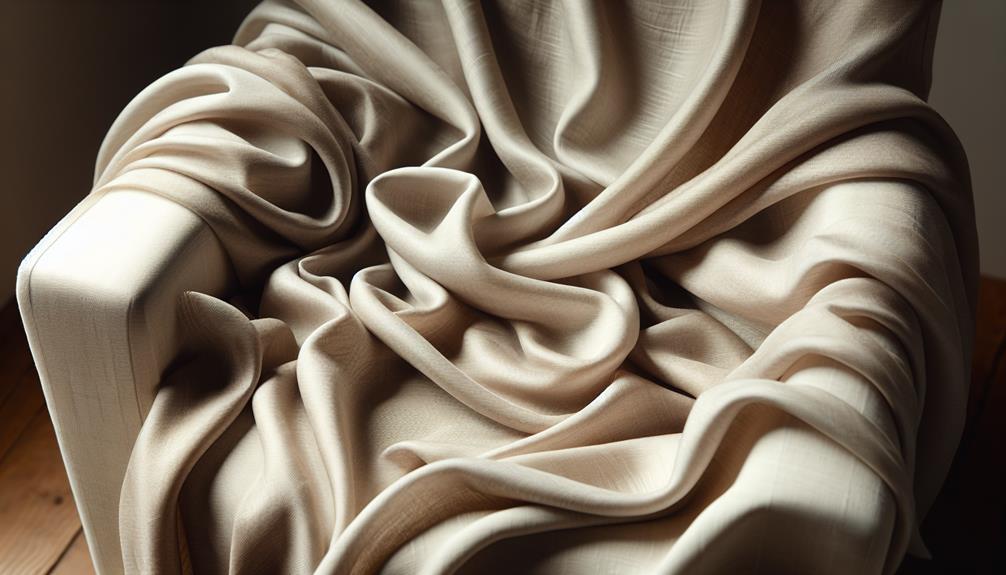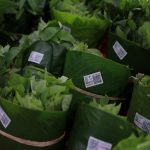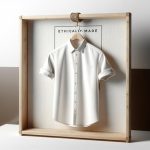Linen fabric? It's all about the luxe, but not always crazy pricey. Factors like high quality, sustainable practices, and those designer touches can amp up the cost. Compared to other fabrics, linen's got that labor-intensive vibe and eco-friendly bonus. Plus, the whole exclusivity game, you know? Some brands pump up prices for that glam factor. And let's not forget the whole historical luxury vibe linen brings to the table. So, if you're curious about why linen's priced the way it is, there's a whole lot more to uncover about this classy fabric!
Table of Contents
Key Takeaways
- Labor-intensive production process contributes to higher costs.
- Premium pricing justified by linen's luxury appeal.
- Exclusive designs and brands influence pricing.
- Limited availability of premium flax plants affects prices.
- Sustainability and eco-friendly nature support higher costs.
Factors Affecting Linen Fabric Pricing
When examining the factors that impact the pricing of linen fabric, it's important to consider the intricate production process involved. The journey of linen starts with the cultivation of flax, a plant known for its strong fibers. These fibers undergo a labor-intensive process, from harvesting to spinning and weaving, ensuring the high quality that defines linen.
This attention to detail and craftsmanship translates into the premium pricing of linen products in the market. What sets linen apart isn't just its quality but also its sustainability and timeless appeal. The exclusivity of linen, influenced by different designs, brands, and origins, further justifies its higher cost compared to other fabrics.
Designers and brands specializing in linen also play a significant role in determining the price of linen fabric, as their reputation adds value to this luxurious material.
Comparison With Other Fabric Costs
Explore how linen fabric compares in cost to other fabrics like cotton.
High-quality linen fabric tends to be more expensive than cotton due to its labor-intensive production and unique qualities. While cotton production has become more efficient and cost-effective over the years, linen's environmentally friendly and sustainable production methods contribute to its higher price tag.
The luxury appeal of linen in the fashion industry also plays a role in its cost in comparison to more common fabrics like cotton. Despite being pricier, the durability, cooling properties, and eco-friendly nature of linen make it a worthwhile investment for those looking for quality textiles.
Influence of Brand and Design
Luxury brands and high-end designers often set premium prices for linen clothing, reflecting the influence of brand reputation on the cost of these garments. When you see a linen piece from a prestigious brand, you're not just paying for the fabric; you're investing in the brand's history, craftsmanship, and status.
The reputation of the designer plays a significant role in the price tag attached to linen products. Exclusive designs and collaborations with renowned brands can also drive up the cost of linen items. Unique patterns and limited edition collections from top designers are highly sought after, making them even more expensive.
Additionally, custom-made or personalized linen pieces from these prestigious brands come at a premium due to their brand influence. So, when you're considering a linen garment from a luxury brand or a high-end designer, remember that you're not just paying for the fabric and design; you're also investing in the brand's prestige and reputation.
Labor and Production Expenses
So, let's talk about the nitty-gritty of why linen fabric can hit the wallet a bit harder.
First off, material sourcing costs are up there, what with the intricate process of getting those flax fibers ready.
Then, don't forget about manufacturing overhead expenses; all those skilled hands and ethical practices come at a price.
Material Sourcing Costs
Sourcing materials for linen fabric involves significant labor and production expenses due to the labor-intensive process of harvesting and processing flax plants. The skilled labor required for these tasks adds to the production costs, as linen production demands careful handling to maintain quality.
Additionally, the slow production pace, attributed to the delicate nature of flax fibers and ethical labor practices, contributes to the overall expenses. The specific climate conditions necessary for cultivating high-quality flax further impact the cost of linen, as this raw material isn't easily obtainable everywhere.
The limited availability of premium flax plants also plays a role in the premium pricing of linen fabric, making it a sought-after but costly textile choice.
Manufacturing Overhead Expenses
In linen fabric production, the overhead expenses for labor and manufacturing are considerably high due to the intricate processes involved in harvesting, retting, scutching, and weaving. These processes are labor-intensive, requiring skilled workers to handle the delicate flax fibers with care. The slow production pace, inherent to the hand weaving of linen, adds to the manufacturing costs.
Additionally, the commitment to fair and ethical labor practices in the linen industry further drives up overhead expenses. The high quality of raw materials used in linen production, alongside the need for skilled artisans and ethical labor standards, contributes to the overall manufacturing overhead expenses, ultimately reflecting the higher price tag of linen fabric in the market.
Quality Control Charges
Quality control charges in linen production greatly impact the final cost of the fabric, encompassing labor expenses and production costs. Skilled labor is essential in the plant for handling the fibers and ensuring quality control. Vital labor practices are essential in maintaining high standards, even though they add to expenses. The time-intensive nature of linen production requires meticulous quality control to uphold superior quality. These quality control charges reflect the dedication to excellence, leading to higher prices for linen fabric.
| Quality Control Charges | ||
|---|---|---|
| Skilled Labor | Vital Labor Practices | Time-Intensive |
| Production Expenses | Labor Costs | High Standards |
Eco-Friendly and Sustainable Aspects
Let's chat about why linen is such a sustainable choice.
First off, linen comes from flax plants that need minimal water and no pesticides, making it a win for the environment.
Plus, linen is biodegradable and recyclable, making it a top pick for those looking to reduce their fashion footprint.
Sustainable Farming Practices
With its minimal water and pesticide requirements, linen fabric stands out as an eco-friendly choice in the textile industry. Flax cultivation, the source of linen fibers, is naturally pest-resistant, reducing the need for harmful chemicals in the farming process. Linen is made from renewable fibers, making it biodegradable and sustainable. Sustainable farming practices in linen production align with environmentally conscious consumer preferences, contributing to the overall sustainability in fashion. This eco-friendly fabric not only offers durability and breathability but also supports a healthier environment through its minimal water usage and pest-resistant properties. Its biodegradability adds to the appeal of linen as a renewable and environmentally friendly material choice.
| Eco-Friendly Aspects | Sustainable Farming Practices | Benefits |
|---|---|---|
| Minimal water usage | Flax cultivation is pest-resistant | Supports sustainability |
| Biodegradable material | Renewable fibers | Environmentally conscious |
| Pest-resistant | Aligns with sustainability | Durable material |
Biodegradable and Recyclable
Linen fabric's biodegradable and recyclable properties make it a sustainable choice for eco-conscious consumers. When linen reaches the end of its lifecycle, it can decompose naturally, unlike synthetic fabrics that linger in landfills for centuries. This eco-friendly characteristic allows linen to be repurposed and reused, reducing waste and promoting sustainable fashion practices.
Low Water Consumption
Linen's reputation as an eco-friendly and sustainable fabric stems from its remarkably low water consumption during production. Unlike thirsty crops like cotton, flax plants used in linen production are water-efficient, requiring notably less water. This reduced water usage not only makes linen environmentally friendly but also aligns with sustainable fashion practices.
The minimal water consumption in linen production highlights its eco-friendly qualities and positive environmental impact. By choosing linen, you're not just opting for a stylish fabric but also supporting a sustainable choice that conserves water resources. Next time you shop, consider the impact of your clothing choices and how opting for linen can contribute to a more sustainable wardrobe.
Perceived Value and Luxury Appeal
Perceived as a symbol of luxury and prestige, linen fabric commands a higher price due to its historical associations and high-end status in the fashion world. When it comes to linen, there's more than meets the eye. Here's why this fabric is seen as a luxurious choice:
- Exclusivity: Linen's limited production compared to other fabrics adds to its allure. The exclusivity factor plays a significant role in its premium pricing.
- Historical Use: With a history dating back centuries, linen has been favored by royalty and nobility. This historical use contributes to its perceived value and luxury appeal.
- Timeless Elegance: Linen exudes a sense of timeless elegance and sophistication. Its ability to effortlessly blend classic charm with modern style makes it a sought-after choice for those who appreciate luxury in their wardrobe.
In the domain of fashion, linen stands out not just for its quality but for the prestige and sophistication it embodies.
Frequently Asked Questions
Is Linen a Luxury Fabric?
Linen exudes luxury with its rich history, exclusive production, and association with nobility. Its timeless elegance and premium quality make it a sought-after fabric in high-end fashion. The labor-intensive process justifies its higher pricing.
Is Linen Cheaper or Expensive?
Linen can be pricier than some fabrics due to its intricate production process. Factors like quality materials and skilled labor affect its cost. Despite being more expensive, linen's durability, breathability, and sustainability make it a valuable investment.
Why Is Linen Fabric so Expensive?
Linen fabric is expensive due to the labor-intensive process of harvesting flax plants, delicate fiber handling, slower weaving, limited high-quality flax supply, specific growing conditions, and its premium quality, durability, eco-friendly production, prestige, elegance, and unique properties.
What Is the Average Price of Linen?
Linen prices vary from $15 to $40 per yard; designer options can reach $100. Clothing ranges $50-$200, luxury pieces over $300. Bedding sets go from $200 to $600, with high-end sets beyond $1000. Custom drapes range from $100 to $500 per panel.
- Tetron Fabric for Marine Applications: Durability and Use Cases - June 18, 2025
- Tetron Fabric for Outdoor Furniture: Weather Resistance and Care - June 18, 2025
- Tetron Fabric for Wall Coverings: Style and Application Tips - June 18, 2025






